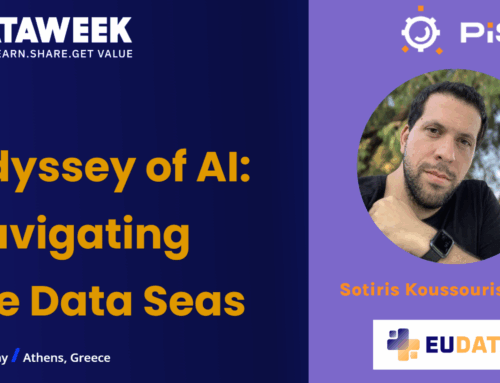The PISTIS project aspires to make a valuable contribution to growing the data economy and towards the monetisation of a company’s data. But what about the potential for PISTIS also to be of value for the Public and “Non-Governmental Organisation” sectors as the project progresses? Let’s take a glimpse into.
The PISTIS partners, whilst focussing on the core project work, also have a broad-ranging interest in the use of all data and in a wide variety of settings. Whilst concentrating on the task in hand, which is providing the technology that will enable enterprises, large and small, to access data of value to them securely and legally and similarly to exploit their own data, we are aware that the underlying technology would still be of great value to the public sector. This would include all the features of the project right up to the point in the PISTIS process where money would change hands for the sharing of data. We will consider here what would be necessary for PISTIS to be able to contribute also from the “data as a public good” aspect, in addition to the “market value of data” perspective which is currently the main focus.
Simply put, and as indicated in the figure below, where additional attention should be focussed is in this final monetisation stage of the platform’s processes, so as to enable both the public and private sectors to equally utilise this emerging technology. Just as the technical solutions will be equally valuable to both sectors, so too would be the cross-cutting aspects of the project, the legal compliance and reduction of ethical concerns, the contracting process and GDPR compliance etc. Deviation in the two paths only occurs at the end of the process. Whereas the private sector would primarily be interested in the financial value which they can achieve from selling their data and from purchasing the data which they may require, the public sector would face a more complex situation of how value is derived and measured through their own perspectives, ambitions, and goals. And this question is pivotal to a large part of the “data market” and we intend that the PISTIS project, along with its wider associates, will help to shape this debate and contribute to making “restricted-use data” more widely accessible as a public good.

Data as a Public good
Within PISTIS, we have already started to consider “Data as a public good”. Indeed, PISTIS itself does provide use-cases which also rely on the public benefit achieved, as well as the monetary rewards. For example: the exploration of new datasets, including previously unknown sources, and establishment of mechanisms for selecting only the right sources that are truly relevant and available on a stable basis will be utilised in a variety of situations within the project.
For example, urban analytics involves utilising urban car traffic quality assessment with a combination of geospatial time series data to generate insights about traffic flows and potential correlation between data sources. This will result in identifying safety-critical zones, forecasting safety risks, and planning congruent actions on both short and long-term horizons. And within the sphere of corporate mobility management, information gathered will entail real-time transportation mode recommendations for commuters through combining individualised commuting data with available modes of transportation. The generated information is also used for incentivising green driving styles and mobility decisions (such as reducing the share of motorised individual transport in the modal split of a commute) and optimising potentials for greener transport in the context of a corporate mobility management. As well as being commercially valuable to the organisations involved, these activities bring significant benefit for the public good. We will return to this aspect in a while.
Similarly, the Smart City of Athens will be in a position to utilise data from a wide variety of sources including open data, to help achieve its goals on behalf of its citizens. Data exchange between the airport, OASA, the public transport agency and DAEM, the city’s IT department, can help improve the overall planning of public transport, allowing the development of services that are able to predict the accuracy of the load within the day to improve route scheduling, the deployment of vehicles and efficient utilisation of its fleet, thus offering to commuters better services and lowering operational costs. The role for PISTIS is to facilitate data trading and sharing between these various sources such as the airport and the city to improve the overall planning of the transportation. And the public benefit from this.
Similarly, from the Airport’s perspective, it is critical to have a transparent and trustworthy source of data about incoming public transportation (frequency, load), to be better prepared for incoming passenger flows. Moreover, this can offer the Airport’s operational staff (e.g., security workers, ATC, cleaning crews etc.) a predictable and time-efficient service for commuting to their workplace, resulting in smooth operations at the Airport.
Further insights will be sought for the commercial businesses operating in Athens. Added value services will be offered across specific areas of interest in the city of Athens based on the analysis and prediction of the “tourist load” expected within the city, informing local businesses on how people are expected to move within the commercial zones of the city, whilst aiming to improve local entrepreneurship and boost businesses’ turnover. Services will be delivered that can improve the mobility experience of the citizens and the visitors to the city, which will lead to an optimisation of mobility services in specific areas (e.g. dynamic passenger transport timetables, less queuing at touristic sites) and could help the Public Transport Operator to adapt, in the longer term, its routes and timetables with regard to touristic/heavy load destinations.
Data shall be traded with the stakeholders involved in the demonstrator, such as the airport and the public transportation system, combined with weather and other events data coming from within the municipality and other open sources (such as local events data, etc.). Many smart cities are now developing their own Digital Twins and recognise the value in being able to access such a wide range of data.
How to make investment decisions.
The opportunities open to many smart cities and the progress they can make towards achieving their goals would be much harder outside the comfort of having access to EU funding. Difficult decisions have to me made regarding the allocation of scarce resources. Making such investment decisions would also be very difficult without the necessary tools being available to assist decision making. A wide variety of academic methods are available for putting a value on data in its capacity as a public good, but are out of scope for the hard-pressed public administrators, requiring expertise in their use and interpretation as well as valuable time. A new set of solutions to help make such decisions simply and which will subsequently bring about the greatest advantages of utilising all the data, which is of potential value to a public administration, needs to be put in place.
The Story of data
Given that cities had no expectation to sell their data, and for a long period have been obliged to open up their data for wider use, the use of market mechanisms is not the norm. Indeed, where money changed hands to the dismay of cities, it was often to “buy back” their own data from outsourced IT contractors. When funding was made available for releasing open data, the goal was for the data economy to benefit, and little resources went to the public sector to access and utilise such data. So with no concern or familiarity with data valuations, as is in common with elsewhere in the economy, and the growth of the huge non-European corporations, cities are faced with more complex decisions as to whether or not to invest in acquiring data. What is currently being created for the private sector in PISTIS for valuing data will need radically amending for it to be of use to the public sector, although clearly the encouragement of such use of PISTIS within the local data economy would be of wider direct economic value to all.
A potential non-monetary solution for cities to tap into the value of open data, can be the development of data narratives. The concept involves turning the tables of a typical data valuation flow and starting from the story that cities would like to communicate to citizens and stakeholders (e.g., revenues from tourism in areas of Athens, improvement of public transport predictability etc.) and then gradually working the way back to the information needs, to the analyses required to meet them, all the way down to the raw available data. Systems that are able to generate data narratives have been around for a decade now, but with increased requirements from users and legislators for explainability and transparency of big data solutions and with the new technological capabilities opened by Generative AI, future R&D efforts will likely focus on brand new approaches of promoting data value through data storytelling.

Core issue: What is the value to be put on data in a smart city?
We should follow the recommendation of the Safe-DEED project and undertake a novel exercise to come up with a sensible answer to be used in developing the necessary business models. There are numerous and often contradictory mechanisms for putting a value on data. A definite approach to doing this within a smart city context needs to be embarked upon.
Impact-based approaches to data valuation
The success of these approaches consists in the fact that they are able to tell compelling stories based on data and connect them to clear outcomes and contexts. This is also echoed by the Data Narratives approach, which acknowledges that “the value of big data is not data, but the narrative that it generates and supports”. Safe-DEED recognised that this entire narratives approach is very interesting. “Starting from the story (the communication) itself, and define the information needs, which in turn defines the kind of analyses that can be performed with the facts at hand. Finally, the required facts define how you are going to derive these elements of information from the data you have”.6 Attention was drawn to the fact that “Data wrapped in stories are twenty-two times more memorable than bare facts”. Safe-DEED also recommended that we need to focus also on “reporting the results either by well-documented subsequent aggregations and by implementing a labelling / certification system”. A common and joined up way of understanding the value of data within the smart cities environment is well worth pursuing as research focused specifically on contexts for data value is almost non-existent,
Innovative new Business Models
“A greater understanding of the value of data would help identify where the benefits of greater investment in and sharing of data are worth the costs. Given the public good characteristics of data, it seems likely that there is considerable untapped value in enabling greater provision, access to, and joining up of data sets”. Developing the correct “European values based” business model for creating the value- and for sharing this value, within a smart city context could enable potential contributions to be made towards the 17% of the overall contribution expected to be made towards achieving net zero, by the cities themselves. This would be the “icing on the cake” in addition to the value which the actual use of the data has for the city.






